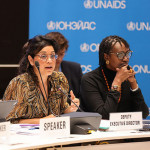 |
| Deborah L. Birx, MD |
Imagine a world where we have everything we need to reduce new HIV infections by 90 percent. Imagine the creation of an AIDS-free generation, the end of HIV as a public health threat.
An AIDS-free generation. This is not a distant dream – it is the extraordinary moment before us right now.
This week at the United Nations General Assembly, the U.S. government set a bold, new course to seize it. In remarks on Sunday on Sustainable Development Goals, President Obama once again led the way stating,
“As more countries take ownership of their HIV/AIDS programs, the United States is setting two new bold goals. Over the next two years, we’ll increase the number of people that our funding reaches — so that nearly 13 million people with HIV/AIDS get lifesaving treatment — and we’ll invest $300 million to help achieve a 40 percent reduction in new HIV infections among young women and girls in the hardest-hit areas of sub-Saharan Africa. And I believe we can do that — the first AIDS-free generation.”
At the UN and SDG Summit, the Administration launched ambitious new PEPFAR HIV prevention and treatment targets for 2016 and 2017. By the end of 2017, PEPFAR will support 12.9 million people on life-saving anti-retroviral treatment – nearly a doubling of people on treatment from 2013 to 2017, provide 13 million male circumcisions for HIV prevention, and reduce HIV incidence by 40 percent among adolescent girls and young women within the highest burdened areas of 10 sub-Saharan African countries.
Every year, 380,000 adolescent girls and young women are infected with HIV—7,300 every week, over 1,000 every day. This must change. That is why the Administration also announced, through PEPFAR, that it is now investing nearly half a billion dollars to support an AIDS-free future for adolescent girls and young women. This includes strategically aligning $300 million in additional HIV prevention investments secured from program efficiencies and effectiveness gained from focusing resources for the greatest impact in the areas of the highest HIV/AIDS burden. This investment builds on $210 million that PEPFAR and private partners committed to DREAMS on World AIDS Day 2014 which will ensure that adolescent girls and young women have an opportunity to live Determined, Resilient, Empowered, AIDS-free, Mentored, and Safe lives.
To aid these efforts, today, PEPFAR is inviting new partners, including the private sector, to contribute new resources and ideas to spark innovation into the DREAMS partnership. Only by working together can we best meet the complex needs of adolescent girls and young women in sub-Saharan Africa.
In bipartisan partnership with the U.S. Congress, President Obama has invested nearly $50 billion through PEPFAR, building on the $15 billion committed by President Bush. Our shared engagement on PEPFAR’s investment strategy and program oversight has ensured these critical resources have had a maximum impact on the epidemic. This has helped to drive down both new HIV infections and AIDS related deaths by more than 40 percent since the peak of the epidemic. PEPFAR’s new targets and investments will help us to meet the challenge before us in the new SDGs: to end the AIDS epidemic by 2030.
No one can do this alone – we all share responsibility. It will take all sectors of society pulling together. This is why PEPFAR is collaborating closely with partner governments, the Global Fund to Fight AIDS, Tuberculosis and Malaria, the UN family, the private sector, and civil society, including faith-based organizations to reach this shared goal.
This week, PEPFAR announced that it will make a $10 million contribution to the Robert Carr Civil Society Networks Fund (RCNF) Replenishment over the next three years to build the capacity of civil society and bring often marginalized populations out of the shadows and into healthcare clinics. Also, PEPFAR and UNAIDS are proud to launch a $4 million two-year initiative to strengthen the capacity of communities of faith to implement the most effective HIV prevention and treatment programs to end AIDS as a public health threat by 2030..
We have come a long way, but the work is far from done. We must strengthen our collective resolve and redouble our efforts so we can finish what we started.
This is our chance. The path is clear. Now let’s get it done.







Comments
Comments